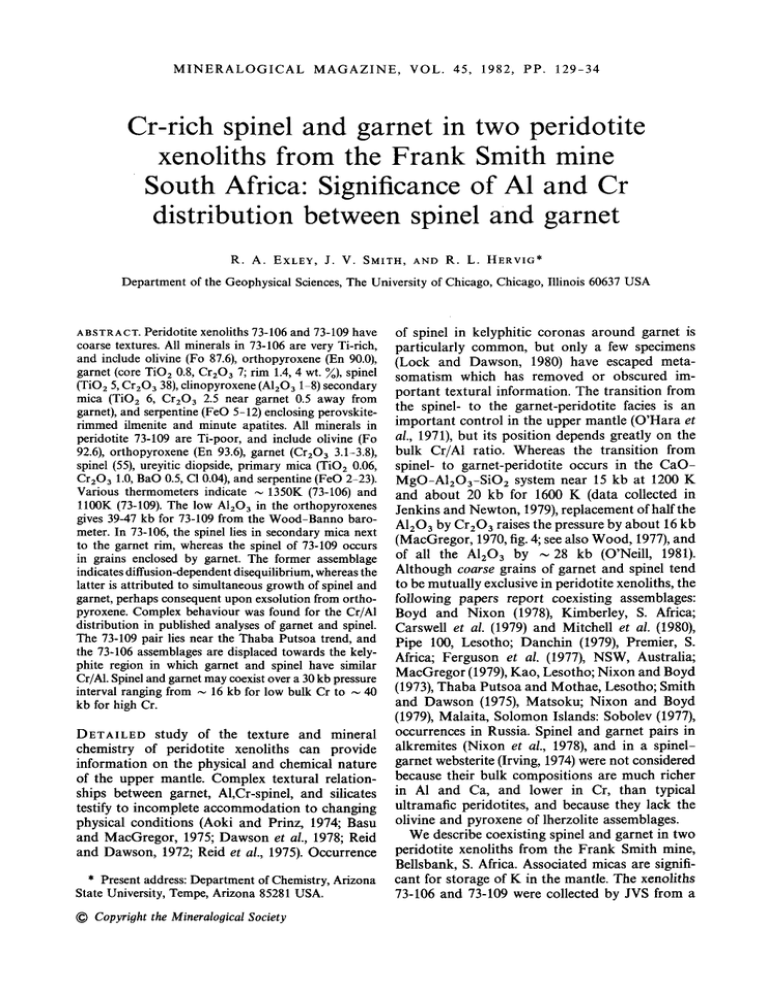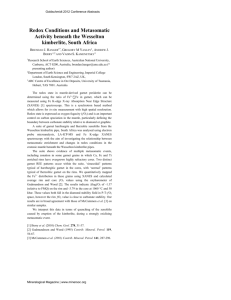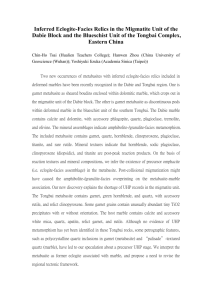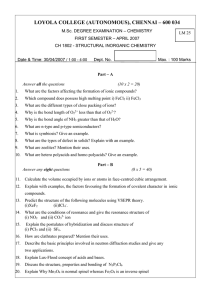Cr-rich spinel and garnet in two peridotite xenoliths from the Frank
advertisement

M I N E R A L O G I C A L MAGAZINE, VOL. 45, 1982, PP. 129-34
Cr-rich spinel and garnet in two peridotite
xenoliths from the Frank Smith mine
South Africa: Significance of A1 and Cr
distribution between spinel and garnet
R. A. EXLEY, J. V. SMITH, AND R. L. HERVIG*
Department of the Geophysical Sciences, The University of Chicago, Chicago, Illinois 60637 USA
ABSTRACT.Peridotite xenoliths 73-106 and 73-109 have
coarse textures. All minerals in 73-106 are very Ti-rich,
and include olivine (Fo 87.6), orthopyroxene (En 90.0),
garnet (core TiO2 0.8, Cr203 7; rim 1.4, 4 wt. ~o), spinel
(TiO 2 5, Cr203 38), clinopyroxene(A1203 1 8) secondary
mica (TiO2 6, Cr203 2.5 near garnet 0.5 away from
garnet), and serpentine (FeO 5-12) enclosing perovskiterimmed ilmenite and minute apatites. All minerals in
peridotite 73-109 are Ti-poor, and include olivine (Fo
92.6), orthopyroxene (En 93.6), garnet (Cr203 3.1-3.8),
spinel (55), ureyitic diopside, primary mica (TiO2 0.06,
CrzO 3 1.0, BaO 0.5, C1 0.04), and serpentine (FeO 2-23).
Various thermometers indicate ~ 1350K (73-106) and
ll00K (73-109). The low A1203 in the orthopyroxenes
gives 39-47 kb for 73-109 from the Wood-Banno barometer. In 73-106, the spinel lies in secondary mica next
to the garnet rim, whereas the spinel of 73-109 occurs
in grains enclosed by garnet. The former assemblage
indicates diffusion-dependentdisequilibrium,whereas the
latter is attributed to simultaneous growth of spinel and
garnet, perhaps consequent upon exsolution from orthopyroxene. Complex behaviour was found for the Cr/AI
distribution in published analyses of garnet and spinel.
The 73-109 pair lies near the Thaba Putsoa trend, and
the 73-106 assemblages are displaced towards the kelyphite region in which garnet and spinel have similar
Cr/AI. Spineland garnet may coexistover a 30 kb pressure
interval ranging from ~ 16 kb for low bulk Cr to ~ 40
kb for high Cr.
DETAILED study of the texture and mineral
chemistry of peridotite xenoliths can provide
information on the physical and chemical nature
of the upper mantle. Complex textural relationships between garnet, A1,Cr-spinel, and silicates
testify to incomplete accommodation to changing
physical conditions (Aoki and Prinz, 1974; Basu
and MacGregor, 1975; Dawson et al., 1978; Reid
and Dawson, 1972; Reid et al., 1975). Occurrence
* Present address: Department of Chemistry, Arizona
State University, Tempe, Arizona 85281 USA.
t~ Copyright the Mineralogical Society
of spinel in kelyphitic coronas around garnet is
particularly common, but only a few specimens
(Lock and Dawson, 1980) have escaped metasomatism which has removed or obscured important textural information. The transition from
the spinel- to the garnet-peridotite facies is an
important control in the upper mantle (O'Hara et
al., 1971), but its position depends greatly on the
bulk Cr/A1 ratio. Whereas the transition from
spinel- to garnet-peridotite occurs in the CaOMgO-A1203-SiO 2 system near 15 kb at 1200 K
and about 20 kb for 1600 K (data collected in
Jenkins and Newton, 1979), replacement of half the
A120 3 by Cr20 3 raises the pressure by about 16 kb
(MacGregor, 1970, fig. 4; see also Wood, 1977), and
of all the A120 3 by ~ 28 kb (O'Neill, 1981).
Although coarse grains of garnet and spinel tend
to be mutually exclusive in peridotite xenoliths, the
following papers report coexisting assemblages:
Boyd and Nixon (1978), Kimberley, S. Africa;
Carswell et al. (1979) and Mitchell et al. (1980),
Pipe 100, Lesotho; Danchin (1979), Premier, S.
Africa; Ferguson et al. (1977), NSW, Australia;
MacGregor (1979), Kao, Lesotho; Nixon and Boyd
(1973), Thaba Putsoa and Mothae, Lesotho; Smith
and Dawson (1975), Matsoku; Nixon and Boyd
(1979), Malaita, Solomon Islands: Sobolev (1977),
occurrences in Russia. Spinel and garnet pairs in
alkremites (Nixon et al., 1978), and in a spinelgarnet websterite (Irving, 1974) were not considered
because their bulk compositions are much richer
in A1 and Ca, and lower in Cr, than typical
ultramafic peridotites, and because they lack the
olivine and pyroxene of lherzolite assemblages.
We describe coexisting spinel and garnet in two
peridotite xenoliths from the Frank Smith mine,
Bellsbank, S. Africa. Associated micas are significant for storage of K in the mantle. The xenoliths
73-106 and 73-109 were collected by JVS from a
R. A. E X L E Y E T AL.
130
T~LE I.
I
P205
SiO2
TiO2
O.06
41.2
0.84
2
3
0.03
O.Ol
42.2
1.36
39.6
Electron microprobe analyses of 73-I06
4
5
6
7
8
nd
nd
nd
nd
nd
57.1
54.5
48.1
37.5
37.8
0.03
0.19
O.l?
1.7
5.7
5.6
9
I0
I]
12
]3
nd
34.3
40.5
0.5
51.0
54.5
18.1
19.6
0.02
0.76
1.7
7.8
14.4
14.7
16.2
0.4
0.7
Cr203
6.7
3.6
0.04
0.34
1.3
2.2
2.5
0.5
38.2
0.8
nd
5.6
18.8
l 0.7
26.9
1.8
9.3
8.3
MnO
0.36
0.29
MgO
19.I
19,5
I1.6
O.ll
49.0
6.84
3.9
5.9
5,7
6.8
O.ll
0. I?
0.2
O.l
O.l
14.5
19.5
19.7
34.7
17.8
0.4
0.6
5.14
Al203
Fe203
FeO
0.6
0.16
12.5
4.7
0.19
40.4
41 .l
12.4
0.7
nd
10.5
0.4
0.2
39.4
Ni 0
0.02
nd
O.41
O.12
nd
nd
nd
nd
0. ?5
CaD
5,8
5.3
0.05
0.89
18.0
18.3
nd
nd
nd
Na20
0,08
0,08
O.Ol
0.17
1.5
1.5
0.2
0.4
nd
nd
nd
nd
nd
nd
nd
nd
10.6
] O. 7
nd
nd
98.9
100.3
98,8
96.3
K20
Sum
101.g8
100.86
P
0.007
0.004
Si
5.935
6.049
Ti
0.091
0.147
AI
3,073
3.311
Cr
0.763
0.408
100.88
0.974
101.22
87.8
3.916
3.980
3.538
5.397
5,437
0.010
0.005
0,094
0.617
0.606
0.001
0.062
0,147
0,676
2.442
2.492
O.OOl
0.018
0,075
0,128
0,284
0.057
88.7
6.844
O.141
96.94
7,720
0.090
Fe3+
Fe2+
1.120
0.995
0.239
0,393
0.238
0.363
0.686
0.818
Mn
0.044
0.035
0,002
0.006
0,006
O.Ol2
O.Ol2
0,012
Mg
Ni
4.101
O.002
4.166
1.797
O.008
3.547
O.006
1.938
1,590
4.183
4,224
Ca
0.895
0.814
O.OOl
Na
0,022
0.022
0.055
O.l l 2
l . 946
1. 964
0.065
1.409
1.442
0.023
0,212
0.214
K
Sum
16,053
15.951
3.023
0
24
?4
4
8.046
12
8,010
12
B.057
12
2.086
12.015
0.749
II.677
101,8
>98,3
0,031
O.ll0
0,755
7.048
0.093
7.596
3.729
0.087
0.153
5.899
O.ll6
0.823
l . 480
3.071
4.134
0.032
O.IO9
3,610
O.039
2.876
O.llO
0.040
7,824
0.279
15,632
15.722
21,086
20,236
18,000
16.000
16.055
82
22
28
28
24
24
24
1,2 interior and edge of garnet; 3 olivine; 4 orthopyroxene; g clinopyroxene AI~O~ 1,4-2.3, Na20 1,2-1.8 for eight analyses, some variations in
major elements; 6 clinopyroxene, unusual Al-rich area; 7,8 high- and 1ow-Cr micas, 9, lO high- and low-Fe serpentines; I I spinel; 12 ilmenite.
minor elements vary considerably; 13 perovskite, probably >1% fib20 . WDS and EDS analyses for 1-8; EDS only for 9-13, For oxides, Fe203
calculated for integral formulae.
Analysts: R.A. Exley and R.L, ~ervig. nd not detected
heavy concentrate of crushed kimberlite during the
First International Conference on Kimberlites.
Both xenoliths display a coarse texture of olivine
and orthopyroxene, but the detailed textural relationships of garnet, clinopyroxene, Cr,Al-spinel,
and mica are partly obscured by alteration to
serpentine. Much of the serpentine is associated
with a multitude of small black specks which are
tentatively identified as graphite by analogy with
microphotographs in Pasteris (1981). Wide ranges
of Fe content of serpentine in both samples (Tables
I and II) suggest local variation in oxidation state.
Specimen 73-106 is a lherzolite with scattered
grains of garnet ( ~ 1 mm) surrounded by a brown
'kelyphitic' rim rich in K. A 20/~m rim of garnet
contains less Cr than the interior (Table I). Small
random grains ( ~ 0.1-0.2 mm) of pleochroic, foxyred, Cr-poor mica (cf. Delaney et al., 1980) are
mostly surrounded by serpentine which does not
traverse the mica, while grains of Cr-rich mica
(Table I) abut the kelphite rim (fig. la). Cr-rich
spinel of uniform composition occurs as unaltered,
often euhedral, grains surrounded by kelyphitic
mica. Mg-rich ilmenite grains are rimmed by
perovskite (cf. Haggerty, 1973) and surrounded by
serpentine which encloses tiny crystals of apatite.
TABLEIf. Elect~nmicroprobeanalyses of 73-109
1
2
P205
0.04
5i02
TI02
42.6
0.008
O.06
42.0
AI203
Cr203
21,2
3.83
nd
22.1
3.1
3
o,Ol5
90.6
nd
0,005
0,011
4
5
nd
58.6
O,06
54.5
6
O.005
41.2
6.85
0.47
20.7
7,64
7.05
0.44
20.8
0.09
53.2
CaO
5.17
5.10
nd
0,014
nd
100.89
Sl
6,019
T|
61
0.001
3,030
3,679
Cr
0,428
0.346
0,809
0.056
4,360
0.001
0.783
0.004
0,902
0.052
4.375
15,996
24
16.053
Z4
Fe3+
Fe2+
Mn
Mg
NI
K
5~
0
0.005
nd
nd
]01.24
O, 007
5.926
p
9
40.8
37.0
nd
0.05
0,09
0.72
0.28
3.42
1.93
14.0
1.01
12,0
-
0.6
3.9
2.3
54.8
3.4
MnO
M90
Na20
K20
Sum
8
nd
0.12
0.D06
Fe203
FeO
7
4.47
0.12
36.6
2.40
2,68
0,07
15,9
0,02
26.7
16.0
0.14
0.4I
0.095
~d
0.04
11,2
O.11
G,O
0.20
19.4
O,Oi
0.04
nd
nd
10128
0.06
nd
101,]5
2.47
nd
101.15
0.62
9.5
96.613
nd
nd
97.90
0.972
0.141
O.OO2
1.903
o,0(~
0.771
*
3,961
O. OOl
5.752
0.OO6
0,057
O.~
2,384
0.015
0,109
O.lll
0.252
0, OO7
3,687
0.144
0.004
1.601
0,313
0.002
5.556
0,027
0.002
0.168
1.693
15.935
o.oo5
0.015
o. OQIB
3,026
4
O. 003
3.895
8.007
12
-
1.4~
0,372
7.91Z
lZ
22
0.025
0.014
2,903
8.894
O. 526
2,747
0.025
3.427
0,018
0,009
18.000
24
44,2
11.7
0.4
30.7
-
-
-
-
87.9
7.592
0.132
0.358
12,260
7.110
0,883
1,880
0.065
10.511
-
-
-
-
20.342
28
20.449
28
I ~ 6190- a~d low-C~" l i m i t s of garnet; 3 ol~vine; 4 orthopy~•
A I 2~~ end 0r20u3
y vary about lO5 0 clinopyroxene; 6 mfca, also BaO 0.67,P~9 (~ 0.013,C1 0.04;
p~bab
89.7
7 Ct-spinel; 8,9 low- and h i g h - F e l i m i t s o f serpentine, CoeYJinatibn of WDS and EDS
analyses f o r 1-7; EDS only f o r 8,9. Analysts: R.A. Exley and R.L. Hervig. nd not
detected.
PERIDOTITE XENOLITHS
FIG. 1. Photomicrographs. (a) 73-106. Partly altered
garnet (high relief) with rim of mica (light areas with
cleavage traces) enclosing euhedral spinel (black). Finegrained serpentine occurs at the upper margin. Plane
polarized light, 1 mm across. (b) 73-109. Spinel inclusions
(dark) in garnet (light). Plane polarized light, 0.5 mm
across.
The olivine and orthopyroxene grains are traversed
by irregular veins of serpentine which appear to
have filled brittle fractures. No exsolution lamellae
or inclusions were seen in the multiply cleaved
grains of orthopyroxene. Some of the small clinopyroxenes (0.1 ram) are associated with garnet and
mica, and show variation of A1 and Na (Table I).
Interpretation of the textures is difficult because of
the serpentinization, but the following sequence is
suggested: (a) prolonged annealing to produce a
garnet lherzolite with coarse texture; (b) reaction
of garnet with other silicates to produce a finegrained kelyphitic rim, probably of orthopyroxene,
clinopyroxene and spinel by analogy with Lock
and Dawson (1980): some diffusion of Cr and other
elements from the surviving garnet was also involved; (c) grain-boundary infiltration of K, volatiles and other elements to produce mica at the
expense of orthopyroxene and most of the clinopyroxene; and (d) serpentinization associated with
formation of graphite and alteration of ilmenite to
perovskite. Stages (b) and (c) may have been partly
concurrent. There is no textural evidence that
requires derivation of the spinel by exsolution from
orthopyroxene, but exsolution of either garnet or
131
spinel or both might have preceded stage (a).
Because all the minerals are comparatively rich in
Ti (Table I), the ilmenite may have existed as
primary grains in stage (a); however, it might be
attributed to stage (c) by analogy with the 'primarymetasomatic' assemblages described by Harte and
Gurney (1975). Calcite and sulphides were not
detected.
Specimen 73-109 is a coarse garnet lherzolite
dominated by olivine and orthopyroxene grains up
to 3 mm across. The cores of the orthopyroxene
grains are filled with long, thin platelets (up to
500 • 20 • 2 #m) of spinel, and the rims are clean
(cf. Basu and MacGregor, t975). In spite of this
obvious zoning, the variation in AI and Cr is small
(a maximum of 10 ~o from the mean value; Table II).
Garnet grains (0.2-0.5 rnm) tend to be associated
with clinopyroxene grains ( < 0.05 mm). Some
garnet grains contain elongated and somewhat
rounded inclusions of spinel ranging from a few
random individuals to 'sprays' which tend to form
curved arrays (fig. lb). This assemblage is quite
different from the fingerprint type of intergrowth
between spinel and other silicates (Smith and
Dawson, 1975), and the closest textural match is
with two zoned garnet xenocrysts with inclusions
of equant acicular grains of Cr-spinel (Sobolev,
1977, pp. 38 and 41). A single large mica crystal
(2 mm) appears to be in textural equilibrium with
adjacent silicates as in primary-textured micas
(Delaney et al., 1980).
Mineral chemistry. Electron microprobe analyses
were obtained with an ARL-EMX-SM instrument
using a combination of energy- and wavelengthdispersive techniques. Three figures after the decimal point indicate spectrometer analyses with a
detection level not worse than 0.005 wt. ~o (ltr),
two figures indicate spectrometer analyses with a
detection level not worse than 0.02 wt. ~ , and one
figure indicates energy-dispersive analyses with a
detection level near 0.1 wt. ~o. Analytical conditions were similar to those in Delaney et al. (1980).
Olivine and orthopyroxene are essentially
homogeneous; m# (atomic Mg/[Mg + Fe]) is higher
in 73-109 (ol 0.926, opx 0.936) than in 73-106 (0.876,
0.900), and this is accompanied by lower Ti, Ca,
and Na. Clinopyroxene in 73-109 also has high m#
(0.936), and is a ureyitic diopside in the classification of Stephens and Dawson (1977). The mica in
73-109 falls neatly into the composition range of
primary-textured micas (Delaney et al., 1980), and
has particularly low Ti (0.06 wt. ~).
All minerals of 73-106 are Ti-rich. The garnet is
remarkable for its high contents of both Ti and Cr
which match quite well into those for garnets in
group I harzburgites from Premier (Danchin, 1979),
but not particularly well with any of the reference
132
R. A. EXLEY ET AL.
compositions of the twelve classes of garnet recognized by Dawson and Stephens (1975). All the mica
is very high in TiO 2 (5.6 ~), even for a secondarytextured type (Delaney et al., 1980), and the substantial increase of Cr203 from 0.5 wt. ~ in grains
not associated with garnet to 2.5 wt. ~ in ones
surrounding garnet indicates the importance of
outward diffusion of Cr into mica from garnet. This
is confirmed by the existence of a 20/~m rim of
lower C r 2 0 3 (3.6 wt. ~ ) around the core (6.7
wt. ~ ) of each corroded garnet. Whereas most
analyses of clinopyroxene show moderate A1203
(1.4-2.3 wt. ~ ) and low TiO2 ( < 0.4 wt. ~o by EDS
analysis) like those of the diopside group (Stephens
and Dawson, 1977), one grain in kelyphite (fig. la)
has unusually high A120 3 (7.8 wt. ~o) and TiO 2
(1.7 wt. ~). Although the higher TiO2 (1.4 wt. ~ )
in the rim than in the core (0.8) of the garnet might
be used as evidence for the introduction of Ti from
metasomatic vein formation, the possibility that
original Ti-zoning remains unaffected should be
considered. The TiO2 content (5 wt. ~o) of the
spinel is rather high (Haggerty, 1975), but the
compositions of the ilmenite and secondary perovskite are unexceptional.
Spinel in 73-109 is chemically uniform, and has
higher Cr/A1 (3.1) than the spinel (1.6) in 73-106,
but the m9 ratios are similar. The garnet in 73-109
is a low-Ca pyrope with nearly uniform composition in each grain irrespective of whether spinel
inclusions are present; however, Cr203 varies
slightly from grain to grain (3.8-3.1 wt. ~ ) and
FeO varies antipathetically.
A limited data set was given previously (Delaney
et al., 1979) for 73-106, and for another garnet
lherzolite, 73-105, from Frank Smith. The latter
lacks spinel, but is otherwise similar to 73-106, in
particular in having garnet zoned from a Cr-rich
core to a Cr-poor rim. These two lherzolites are
unusual for high Ti, Cr, and Na in the minerals,
and for temperatures (next section) very high for
lherzolites with coarse textures; they appear to be
transitional in these respects to porphyroclastic
lherzolites.
Estimates of temperature and pressure. As is
common with small nodules, textural information
is obfuscated by serpentinization and equilibrium
is tested here by using various mineral pairs as
thermometers. To mitigate problems with zoned
crystals, emphasis is placed on coarse grains with
uniform composition, and on the fairly homogeneous interiors of zoned grains.
Temperatures (Table III) for garnet-olivine
(O'Neill and Wood, 1979), for two pyroxenes
(Wells, 1977), and for two minor-element thermometers calibrated empirically against the Wells
thermometer, are in general agreement. A best
estimate of 1350 K for the silicates in 73-106
excludes the high value of 1460 K for the lowest
Na analysis of clinopyroxene. F o r 73-109, three
temperatures cluster within 10 degrees of 1090 K,
while the Wells thermometer for MgSiO3 exchange
between ortho- and clinopyroxene is 100 K higher.
Perhaps the clinopyroxene did not reach equilibrium with the other three silicates; for the latter
a rounded value of 1100 K is suggested.
There is considerable controversy over the application of barometers, but it does not seem profitable to pursue details. The Wood and Banno (1973)
orthopyroxene-garnet barometer gives pressure in
the range 39 to 47 kb for 73-109 when account is
taken of chemical zoning. Similar orthopyroxene
compositions in 73-t06 suggests a comparable
pressure range. The coarse texture of both samples
is typical of the textures of many peridotite nodules
from S. African kimberlites which Boyd (1973) and
other scientists have attributed to prolonged
annealing near 1300 K and 40 kb.
Origin of spinel-garnet textures. The intimate
relation between the spinel and garnet in 73-109
requires detailed discussion. Simultaneous growth
of the two minerals seems to be the most plausible
explanation of the texture in fig. lb. Each spinel
crystal appears to have grown independently from
the other spinel crystals. All faces are either planar
or convex, and there are no concave or scalloped
indentations that might be indicative of corrosive
transformation of spinel to garnet. Neither does
the texture appear indicative of exsolution of spinel
from garnet, or of transformation of garnet to
spinel. The curvature of the arrays argues against
expitaxial crystallization. Perhaps the simplest
cause of simultaneous crystallization would be
simultaneous exsolution of garnet and spinel components from orthopyroxene in the stability field
TABLE I I I . Estimated temperatures (Kelvin)of
peridotites
1.
2.
3.
4.
GT-OL
OPX-CPX
OPX-CPX
OPX-OL
73-106
73-109
1340
1350
1350,1460
1360
1100
1200
1080
1090
1. O'Neill and Wood (1979): Fe-Mg exchange. 2. Wells
(1977): Mg exchange. 3. Hervig and Smith (1980): Na
exchange. High and low temperatures correspond respectively to low and high Na in the clinopyroxene. 4. Hervig
and Smith (1981): Cr exchange. Revised equation: T
(Kelvin) = 5540/(1.86+1nK) where K = Cr203(OPX)/
Cr203(OL ) in wt. ~o.
PERIDOTITE XENOLITHS
of coexisting garnet and spinel. If this is correct,
diffusion was sufficient to produce a spinel-free rim
in the orthopyroxene, but not sufficient to give a
spinel-free core. Absence of garnet inclusions in the
orthopyroxene might be used as evidence against
simultaneous exsolution of garnet and spinel components, but perhaps the rock had moved out of
the range of garnet stability at the end of the
exsolution process.
Cr,Al-distribution between garnet and spinel. The
model reaction orthopyroxene + spinel = garnet +
olivine marks the transition from the spinelperidotite to the garnet-peridotite facies with
increase of pressure. As already noted, MacGregor
(1970) showed that this transition occurs at greater
pressure in a system with higher Cr/(Cr + AI) as Cr
stabilizes the spinel. Wood (1977) preformed experiments to sudy the effect of Cr20 3 on the
transition, and because of the coupling of Ca and
Cr in garnet, he plotted ln K D ( K D = (Cr/AI)~/
(Cr/A1)sp) vs. Xgt~ for coexisting spinel and garnet
in Lesothan lherzolites analyzed by Nixon and
Boyd (1973), in order to estimate the effect of
non-ideality of garnet on the model reaction. A
more complex version of the plot (fig. 2) incorporates data from papers listed in the introduction.
The most obvious conclusion from fig. 2 is that
kelyphitic spinels inherit the Cr/A1 ratio of the
,
0
i
(~k
i
i
elyphite
Q.
.joo
garnet
('-)2
/
73-106
O
",r
M73
1169 e"
,/.
y/ 695~
II/ ~
core+
6,d
~
go,oat
/~
R
.....
.....
_ _ - ~-z-'~-5- -"
R"
-
~e
56x73-109
i
o
I
0-2
I
X
I
o.4
FIG. 2. Relation between In Ko(Cr/AlgjCr/Al,p) and mole
fraction of Ca in garnet. Symbols: filled circle, Thaba
Putsoa, Nixon and Boyd (1973); filled square, Pipe 200,
Carswell et al. (1979); filled triangle, Kao, MacGregor
(1979); R, Mir, Russia, Sobolev (1977); M, Malaita,
Solomon Islands, Nixon and Boyd (1979);A, SE Australia,
Ferguson et al. (1977); D, Dish Hill, California, Shervais
et al. (1973); open square, Pipe 200, Carswell et al. (1979);
open circle, Letseng, Lock and Dawson (1980);horizontal
and inclined crosses, 73-106 and 73-109, this paper. Small
numbers show t00 mg of spinel.
133
primary garnet, which indicates near isochemical
retention of Cr and AI around the garnet rim
(KD = 1).
Primary-textured spinels and garnets have a
strong preference of Cr for the spinel (K D < 1).
Factors which control the distribution will be complex, but important variables are pressure, temperature, and compositional factors such as Xgca
(which correlates positively with X,c*) and ms.
The five points for Thaba Putsoa, Lesotho (filled
circles) involve spinels in which mg varies only from
63 to 68, and they appear to define an equilibrium
trend (continuous line) already recognized by
Wood. The five points for the Mir pipe, Russia (R)
involve spinels in which mg varies only from 52 to
55, and they also might be attributed to an
equilibrium trend, but quite different from the one
for Thaba Putsoa. Both the Mir and Thaba Putsoa
regions are in stable cratons with similar geotherms
of continental type for the granular peridotites. The
two specimens for Pipe 200, Lesotho (filled square)
are somewhat displaced from the Thaba Putsoa
trend, and that for Kao, Lesotho (filled triangle) is
considerably displaced in spite of similar mg values.
Perhaps a reinvestigation is needed to check
whether there is textural evidence of lack of equilibrium especially for the Kao specimen. The linear
trends at similar K D values for Mir and Thaba
Putsoa indicate an equilibrium distribution corresponding to similar P, T conditions.
The present spinel-garnet pair 73-109 lies closer
to the Thaba Putsoa trend than the Mir trend even
though the mg value of 56 is closer to the range of
52-5 for the latter. For 73-106, it is expected that
the spinel would be in closer relationship to the
rim of the garnet than to the core, and indeed the
rim is closer to the Thaba Putsoa trend than is the
core. It is quite clear that the garnet-spinel relation
is different from that found in the typical kelyphites.
Specimens M (Malaita, Solomon Islands), A
(SE Australia), and D (Dish Hill, California) in fig.
2 are for higher T and lower P. Because reduced
pressure lowers Cr in spinel, higher values of KD
should ensue, and indeed the Australian specimen
and two from Malaita agree with expectation.
However, one from Malaita and the Dish Hill
specimen do not agree, and perhaps late disequilibrium crystallization of spinel may be responsible.
The recent experimental work of O'Neill (1981)
shows that the transition pressure from spinel
lherzolite to garnet lherzolite is raised linearly with
xsC~ for a maximum increase of ~ 28 kb for pure
Cr-spinel. From the present survey of Cr/A1 partitioning, it appears that problems of disequilibrium,
either involving kelyphitization of garnet or late
crystallization of spinel, must be carefully assessed
before this barometer is applied.
134
R. A. E X L E Y E T AL.
Acknowledgements. We thank I. M. Steele, R. Draus,
O. Draughn, and N. Weber for technical help, and NSF
for grant EAR 80-23444.
REFERENCES
Aoki, K., and Prinz, M. (1974) Contrib. Mineral. Petrol.
46, 249-56.
Basu, A. R., and MacGregor, I. D. (1975) Geochim.
Cosmochim. Acta, 39, 937-45.
Boyd, F. R. (1973) Ibid. 37, 2533-46.
- - a n d Nixon, P. H. (1978) Ibid. 42, 1367-82.
Carswell, D. A., Clarke, D. B., and Mitchell, R. H. (1979)
In The Mantle Sample: Inclusions in Kimberlites and
other Volcanics (F. R. Boyd and H. O. A. Meyer, eds.),
Washington; Am. Geophys. Union, 127-44.
Danchin, R. V. (1979) Ibid. 104 26.
Dawson, J. B., and Stephens, W. E. (1975) J. Geol. 83,
589-607.
- - S m i t h , J. V., and Delaney, J. S. (1978) Nature, 273,
741-3.
Delaney, J. S., Smith, J. V., Dawson, J. B., and Nixon,
P. H. (1979) Contrib. Mineral. Petrol. 71, 157-69.
----Carswell,
D. A., and Dawson, J. B. (1980)
Geochim. Cosmochim. Acta, 44, 857-72.
Ferguson, J., Ellis, D. J., and England, R. N. (1977)
Geology 5, 278 80.
Haggerty, S. E. (1973). In Lesotho Kimberlites (P. H.
Nixon, ed.), Maseru, Lesotho National Development
Corporation, 149-58.
- - ( 1 9 7 5 ) Phys. Chem. Earth, 9, 295-307.
Harte, B., and Gurney, J. J. (1975) Carnegie Inst. Washinffton Yearb. 74, 528-36.
Hervig, R. L., and Smith, J. V. (1980) J. Geol. 88, 337-42.
----(1981)
Eos, Trans. Am. Geophys. Union, 62,
1055.
Irving, A. J. (1974) J. Petrol. 15, 1-40.
Jenkins, D. M., and Newton, R. C. (1979) Contrib.
Mineral. Petrol. 68, 407-19.
Lock, N. P., and Dawson, J. B. (1980). Trans. R. Soc.
Edinburgh: Earth Sci. 71, 47-53.
MacGregor, I. D. (1970) Phys. Earth Planet. Inter. 3,
372-7.
- - ( 1 9 7 9 ) In The Mantle Sample: Inclusions in Kimberlites and other Volcanics (F. R. Boyd and H. O. A.
Meyer, eds.), Washington, Am. Geophys. Union,
156-72.
Mitchell, R. H., Carswell, D. A., and Clarke, D. B. (1980)
Contrib. Mineral. Petrol. 72, 205-17.
Nixon, P. H., and Boyd, F. R. (1973) In Lesotho Kimberlites (P. H. Nixon, ed.), Maseru, Lesotho National
Development Corporation, 48-56.
----(1979)
In The Mantle Sample: Inclusions in
Kimberlites and other Volcanics (F. R. Boyd and
H. O. A. Meyer, eds.), Washington, Am. Geophys.
Union, 400-23.
- - C h a p m a n , N. A., and Gurney, J. J. (1978). Contrib.
Mineral. Petrol. 65, 341-6.
O'Hara, M. H., Richardson, S. W., and Wilson, G. (1971)
Ibid. 32, 48-68.
O'Neill, H. St.C. (1981) Ibid. 77, 185-94.
- - a n d Wood, B. J. (1979) Ibid. 70, 59-70.
Pasteris, J. D. (1981) Geology, 9, 356-9.
Reid, A. M., and Dawson, J. B. (1972) Lithos, 5, 11524.
- - D o n a l d s o n , C. H., Brown, R. W., Ridley, W. I., and
Dawson, J. B. (1975) Phys. Chem. Earth, 9, 525 43.
Shervais, J. W., Wilshire, H. G., and Schwarzman, E. C.
(1973) Earth Planet Sci. Lett. 19, 120-30.
Smith, J. V., and Dawson, J. B. (1975) Phys. Chem. Earth,
9, 309-22.
Sobolev, N. V. (1977) Deep-seated inclusions in kimberlites
and the problem of the composition of the upper mantle.
Trans. by D. A. Brown and F. R. Boyd. Washington,
Am. Geophys. Union.
Stephens, W. E., and Dawson, J. B. (1977) J. Geol. 85,
433-49.
Wells, P. (1977) Contrib. Mineral. Petrol. 62, 129-34.
Wood, B. J. (1977) Second Kimberlite Conference
Extended Abstracts, unpaged.
--and
Banno, S. (1973) Contrib. Mineral. Petrol. 42,
109-24.




